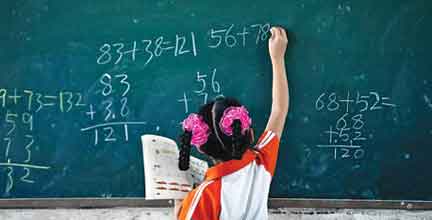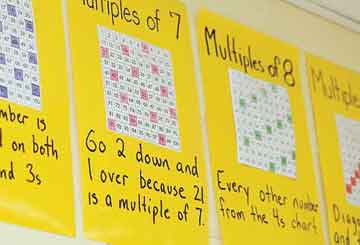Sinny Mole
Recently I had a conversation with one of my colleagues, Supriya (name changed), who teaches mathematics in primary school. She was quite upset and worried about her mathematics class. Her children were reported to be inattentive;most of them scored poor grades in the assessment sessions. She commented about my class children: “Your class children are the blessed ones and well-disciplined. You are lucky!”Her grievance list includes unavailability of readymade power point presentations, teaching tools, and so on.
During my classroom observations, I found that her teaching practices were often textbook-centric. At the beginning of the lesson she often taught children using the blackboard, and thereafter the children attempted the exercises from their textbooks. She wanted to make sure that children could do the textbook problems, so she did not give them an opportunity to think. Lesson plans were prepared and kept in the file for record purposes, but she never used those plans in the classroom.
 “Mathematics is boring” is a common refrain among children who do not like mathematics in primary school. We encourage children to read for enjoyment, yet we never encourage them to do “math” for enjoyment. Mathematics is learned best when children are actively participating in that learning. This is true for teachers as well. Interactions are indeed the heartbeat of a mathematics classroom. The teaching and learning of mathematics is a complex activity and many factors determine its success.
“Mathematics is boring” is a common refrain among children who do not like mathematics in primary school. We encourage children to read for enjoyment, yet we never encourage them to do “math” for enjoyment. Mathematics is learned best when children are actively participating in that learning. This is true for teachers as well. Interactions are indeed the heartbeat of a mathematics classroom. The teaching and learning of mathematics is a complex activity and many factors determine its success.
How you teach is more important than what you teach
Supriya tends to teach the way she was taught and hence many of the practices that developed poor attitudes toward mathematics continued. If we always do what we have always done, then we will always get what we always got – children who hate mathematics. It is not enough for teachers to know about different teaching methods and modes of instruction; they must also know how to implement the strategies in their classrooms. An accomplished teacher employs a variety of generic instructional approaches – how to lecture, how to oversee small cooperative learning groups.
A skillful teacher can “read” her children. When planning a lesson, she can anticipate the concepts and activities that certain children may find problematic. Thus, by keeping a finger on the pulse of the class, such teachers decide when to alter plans, work with individual children or enrich instruction with additional examples, explanations or activities. Teachers can learn from listening to their children and from reading what they write. But such monitoring and learning is not an easy task. Teachers need to develop and sharpen this quality through continuous effort.
We cannot hold a torch to light another’s path without brightening our own
The lack of depth in Supriya’s knowledge of the subject and the lack of initiative to continue professional development in mathematics were some major concerns. Teachers should have access to facilities to strengthen their own knowledge base about various pedagogical strategies that could be effective. It is essential to promote sharing of good teaching practices within the school through in-house mathematics networks and teacher-to-teacher coaching. These opportunities can also be made available through school based professional development as well as by upgrading qualifications through special study, workshops, seminars, etc.
Teachers should have a rich understanding of the lesson they teach and appreciate how knowledge in their subject is created, linked and applied to classroom situations. Accomplished teachers are aware of the pre-conceptions and background knowledge that children typically bring to each lesson and of strategies and instructional materials that can be of assistance. They understand where difficulties are likely to arise and modify their practice accordingly.
Concepts are the substance of mathematical knowledge
Effective teaching requires that common mistakes and misconceptions are systematically confronted and explored within the classroom. Hence it is important to select a variety of experiences and examples with concrete materials to represent the concept adequately. Each new concept makes math come alive for the children. This kind of teaching makes children active participants in the learning process. Through touching and moving objects, the involvement of multiple senses tends to make the learning more permanent. In this way learning becomes an active process of building knowledge and making sense.
 Anything not understood in more than one way is not understood at all
Anything not understood in more than one way is not understood at all
Children make mistakes, even during carefully planned lessons using well-designed instructional materials. They may answer incorrectly, give incomplete answers or may not respond at all. One of the prime responsibilities of a mathematics teacher is to help children learn how to persevere when the problem-solving process becomes difficult. Encourage children to find more than one way of approaching the problem. If you are patient and consistent in your approach and give criticism with compassion, you will have a more significant influence on the child’s subconscious levels of thinking than you realize. You must allow children sufficient time to complete their work, encourage different strategies for approaching and solving problems. Talk to the non-participators about their reasons for lack of participation – perhaps your perceptions could be proved wrong.
The important thing is not so much that every child should be taught, as that every child should be given the wish to learn
No doubt, teaching is a hard job. It’s quite easy to become disheartened. It is believed that rote learning of mathematics causes children to develop anxiety toward the subject. Children are often successful in learning simple mathematics based on rote learning, but as the mathematics becomes more complex they can no longer just learn rules to cover all situations. This is why many children start by enjoying mathematics but as they get older they are turned off by the subject.
Children’s unwillingness to participate in the mathematics classroom arises from lack of understanding and fear of making errors. Do not be angry if a child does not understand something or makes a mistake, because this can lead to fear of failure. Show the child how to recover from the mistake and try again. It is important that feedback be provided before the child is required to use the skill/knowledge again. While correcting class work, find some time to discuss with the child on the errors made. You may be surprised to know the reasons behind children making mistakes. Such inputs will be quite helpful for you to guide them.
 One should understand that it is for teachers to make mathematics fun and enjoyable, supported by teaching resources that help them to do this. A good teacher understands the stage each child has reached, so that he or she can give children the right amount of challenge and support.
One should understand that it is for teachers to make mathematics fun and enjoyable, supported by teaching resources that help them to do this. A good teacher understands the stage each child has reached, so that he or she can give children the right amount of challenge and support.
If a child can’t learn the way we teach, maybe we should teach the way he/she will learn
There are many factors that may compromise the effectiveness of teaching for children with learning difficulties. It may be linked to differences between home and school, language and culture, or to other social circumstances such as family disruption. Many of such children’s difficulties may be transitory, in that given appropriate early learning experiences, they will be able to catch up with their peers. Some of these children, however, will need ongoing support to cope with the demands of their classrooms.
Supriya used to complain to the school coordinator and the parent about the troublesome behaviour and poor performance of a child in her mathematics class. In fact, the child had learning difficulties and Supriya failed to identify and address it in time.
It is important for schools to create space for those children who will need continued assistance with learning throughout their school lives, as well as for those children who will benefit from early intervention programmes.
Conclusion
Understanding basic mathematics is an essential life skill, and a good start at primary school paves the way for success at upper school and beyond. The best teaching occurs when children take something that the teacher has conveyed and then develop it on their own.
My suggestion to develop a good teaching skill: teacher-to-teacher coaching, participation in workshops and skill development courses. Apply learning and teaching techniques appropriate to your classes. If you have done your job, children will learn on their own and that knowledge will stay with them long after they have left your classroom.
By the way, Supriya is striving to enhance her knowledge and skills. I had the opportunity to support her in the skill development process. Nowadays, I observe a pleasant glow on her face while returning from the classroom. A wonderful transformation! It’s simply ‘math-magic’.
The author is Mathematics Team Leader at K D Ambani Vidyamandir (Primary School), Reliance Greens, Jamnagar. She can be reached at sinny.mole@ril.com.
